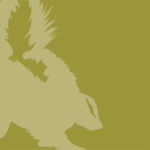
STRIPED SKUNK
Did you know Striped Skunks can send their fowl-smelling spray (which happens to be highly flammable) up to 10 feet?
PROFILE
Febreeze is a cinnamon colored striped skunk that was a surrendered pet to a rehabber in Valdosta. He is de-scented (meaning he can’t spray anyone), but will still try to “skunk” you any chance he gets. He likes to stomp at his keepers to let them know he runs the show inside his enclosure.
OVERVIEW
CONSERVATION STATUS
Least Concern
AVERAGE SIZE
Compared to a 6′ Man
AVERAGE WEIGHT
Females: 4 lbs
Males: 10 lbs
AVERAGE LIFESPAN
3 Years (wild)
15 Years (captivity)
DIET
Omnivore
REGIONS
North America
Found across North America including southern Canada, the United States and northern Mexico. Striped skunks prefer mixed woodlands, brushy areas or open fields that are interspersed with wooded ravines and rocky outcrops.
APPEARANCE
Easy to recognize with their white head-to-tail stripe, almost always on black, the base fur can be brown or cream in color. They are short and stout, with an average weight of about 10 pounds (males) and 4 pounds (females). The front paws are armed with curved claws that are perfect for digging.
CHARACTERISTICS
Second to their distinctive white stripe, their other notable characteristic would be their defense mechanism. They have the ability to spray foul smelling fluid from scent glands located at the base of their tails. This oily musk is painful if sprayed near the eyes. Young skunks have the ability to use this defense even before their own eyes are open.
Mainly an insectivore, striped skunks will occasionally supplement its diet with mice, voles and bird eggs. During growing seasons, they will consume apples, corn and cherries when available. Striped skunks are essentially solitary animals but can sometimes be found in groups, especially through winter months, sharing dens in order to stay warm. Nocturnal animals, they prefer underground dwellings for safety. They often take up residence in hallowed logs, abandoned dens and under buildings.
Breeding season begins mid-February at which time males may breed with multiple females. Litters of 2 to 10 “kits” are born after a 2.5 month gestation period. Young striped skunks will stay close to their mothers until they reach maturity at about 10 months of age. Striped skunks live an average of 7 years in the wild.


